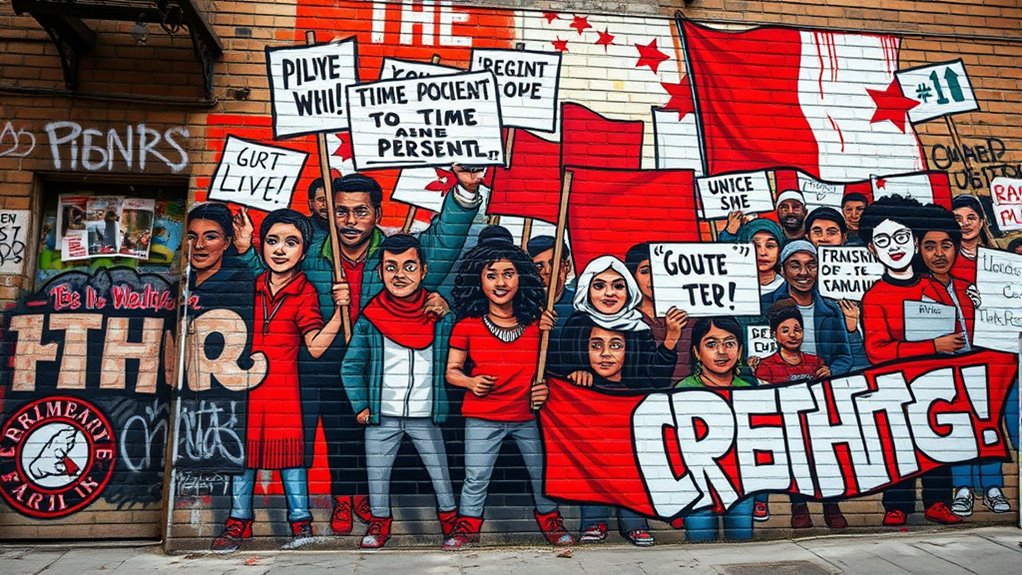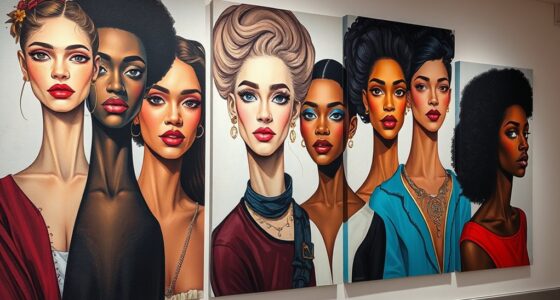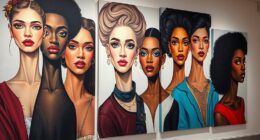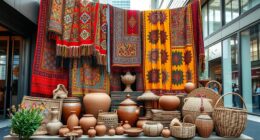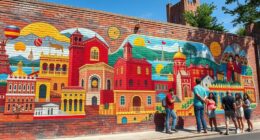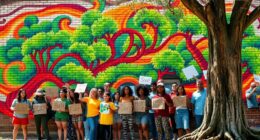Protest art has surged from raw street graffiti to a powerful global voice for social change. You see bold visuals, striking symbols, and provocative messages that challenge authority and amplify marginalized voices. Its evolution has embraced new mediums like murals, posters, and digital platforms, making it accessible and impactful worldwide. If you explore further, you’ll discover how this form of expression continues to inspire action and reshape public perspectives around the world.
Key Takeaways
- Protest art has evolved from revolutionary murals to modern street art, adapting to new mediums and societal contexts.
- It serves as a powerful tool for social commentary, challenging authority and amplifying marginalized voices.
- Techniques like bold colors, stark contrasts, and raw aesthetics enhance its emotional and visual impact.
- Digital platforms and social media have expanded protest art’s reach, transforming it into global movements.
- Its accessibility and confrontational nature continue to influence public opinion and inspire social and political change.
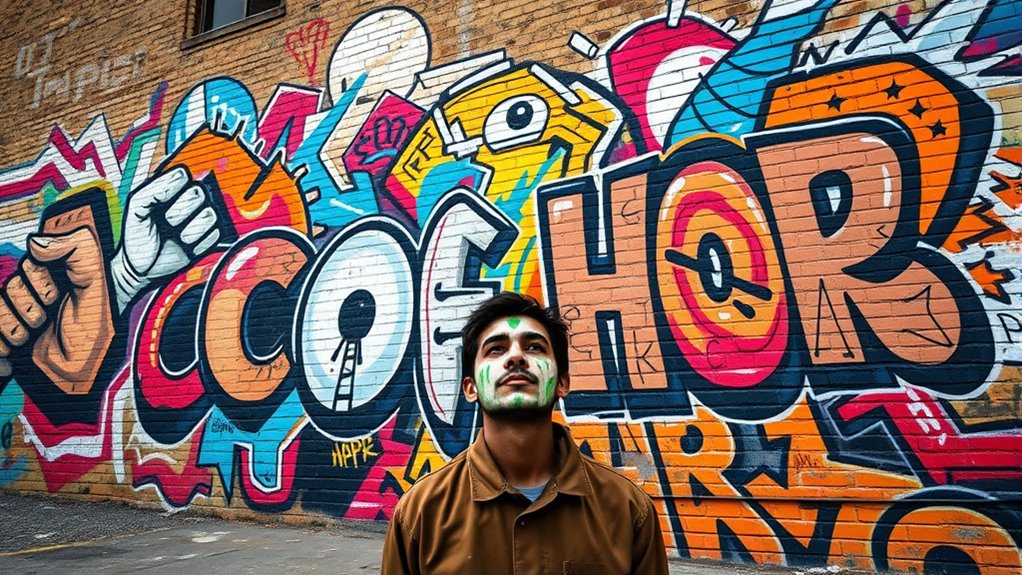
Have you ever wondered how art can challenge power and spark change? Protest art is a powerful form of expression that transcends traditional boundaries, allowing individuals to voice their frustrations, hopes, and demands. At its core, protest art serves as a visual and emotional tool for political expression and social commentary. It distills complex issues into striking images and messages that can cut through silence and apathy, making it impossible to ignore injustice or inequality. When you see a mural, graffiti, or a provocative poster, you’re witnessing a direct response to societal issues—an act of defiance that questions authority and highlights marginalized voices.
Throughout history, protest art has evolved alongside social movements, adapting to new mediums and technologies while maintaining its core purpose. In times of upheaval, artists have used their craft to challenge oppressive regimes, rally communities, and bring visibility to causes that might otherwise be ignored. From the revolutionary murals of Latin America to the politically charged street art of today’s global protests, these works communicate powerful messages that resonate beyond their immediate context. They often incorporate symbols, slogans, and imagery that evoke emotional reactions, inspiring viewers to reconsider their perspectives and perhaps even take action.
You might notice that protest art frequently employs bold colors, stark contrasts, and provocative imagery to grab attention and convey urgency. Its raw, unpolished aesthetic often reflects the immediacy of the issues it addresses. Whether spray-painted on city walls, printed on posters, or projected onto buildings, protest art refuses to be confined within galleries or museums. It belongs to the streets—accessible, temporary, and confrontational. This accessibility allows it to reach diverse audiences, sparking conversations and debates that can ripple outward, influencing public opinion and policy.
In today’s digital age, protest art has expanded into online platforms, where viral images and memes amplify its reach. Social media transforms these visual expressions into global phenomena, enabling activists to mobilize support quickly and effectively. Despite the changing landscape, the essence remains the same: protest art is a visceral form of political expression and social commentary that challenges the status quo. It empowers individuals to voice dissent visually and emotionally, making the invisible struggles visible and demanding change. Whether it’s a painted slogan, a sculptural installation, or a digital collage, protest art continues to be a crucial tool for those seeking justice and equality, reminding us that art can be a catalyst for transformation.
Frequently Asked Questions
How Has Digital Technology Changed Protest Art Strategies?
Digital technology has transformed protest art strategies by enabling you to use digital tools like graphic design software and video editing, making your messages more impactful. Social media allows you to quickly share your artwork with a global audience, amplifying your voice and mobilizing supporters. You can collaborate in real-time, adapt your art swiftly, and reach diverse communities, making your protest art more dynamic and influential than ever before.
Which Historical Protests Most Influenced Contemporary Protest Art?
You might think modern protest art is new, but it’s shaped by iconic moments like the Civil Rights Movement and anti-Vietnam War demonstrations. These protests used political symbolism and cultural expression to challenge norms and inspire change. Ironically, today’s digital murals and viral memes echo those bold visuals, proving that even in a digital age, powerful images rooted in history continue to influence your activism and shape your perspective.
How Do Governments Typically Respond to Protest Art Displays?
Governments often respond to protest art displays with censorship or suppression, fearing public backlash or political instability. They may remove or cover the artwork, arrest artists, or impose restrictions to limit its visibility. This reaction aims to control the message, but it can also fuel further protests. Your understanding of these responses highlights the ongoing tension between creative expression and governmental authority, shaping how protest art evolves under pressure.
What Are the Legal Risks for Artists Creating Protest Art?
When you create protest art, you face censorship challenges and legal repercussions, especially if your work criticizes authorities or sensitive issues. Authorities might arrest you, fine you, or seize your art, claiming it’s offensive or illegal. You could also encounter restrictions on where and how you display your work. It’s essential to understand local laws and risks, so you can protect yourself and continue expressing your views effectively.
How Does Protest Art Impact Public Opinion and Policy?
Protest art shapes public perception by highlighting social issues, sparking conversations, and inspiring empathy. When your art resonates, it can influence public opinion, making people more aware and engaged. This shift in perception often pressures policymakers to contemplate change, leading to policy adjustments. Your creative expression becomes a catalyst for social progress, demonstrating how art can drive real-world impact through raising awareness and mobilizing community support.
Conclusion
As you step back and look at protest art, it’s like witnessing a wildfire of passion igniting change across society. Each bold stroke and vivid image becomes a rallying cry, echoing through time like thunder rolling across the hills. This art is your voice, fierce and unyielding, shaping the landscape of history. Remember, in the dance of protest art, your courage fuels the flame that lights the way for others to follow.

